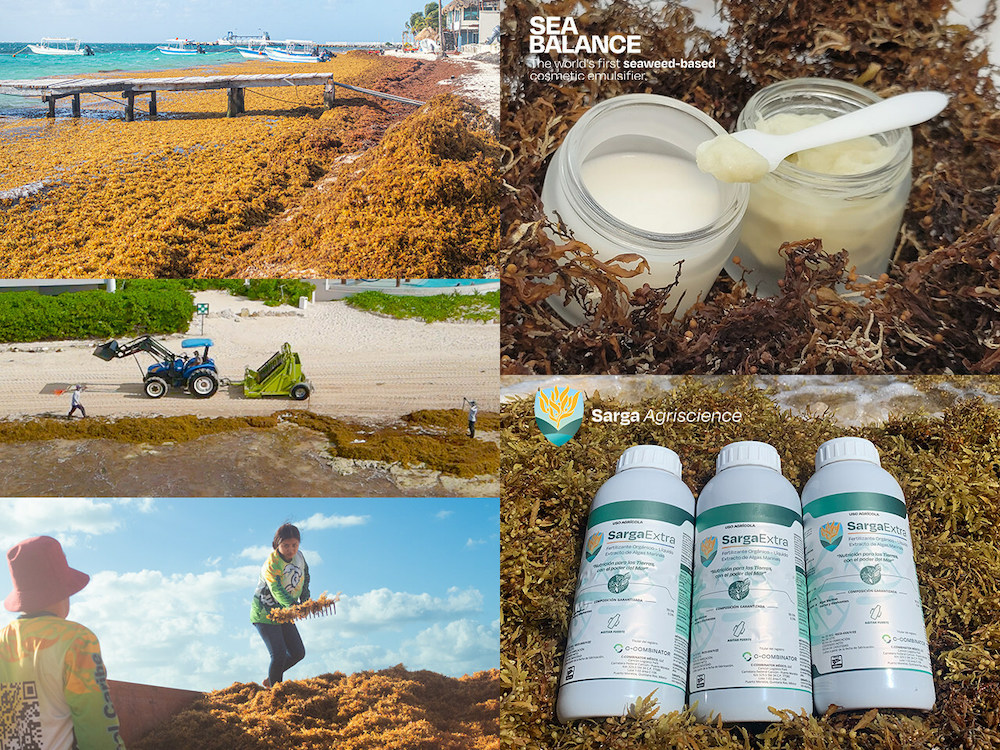
Sargassum seaweed washed up on the beach at Playa del Carmen in Quintana Roo, Mexico. (Image: Thor Tryggvason/Unsplash)
Massive sargassum seaweed blooms have become par for the course in recent years. They’re the result of warming oceans and agricultural nitrogen runoff. As such, the problem is set to only get worse each season.
Fortunately, quite a few startups are working on solutions. One of them is Boston-based Carbonwave. The bio-material processor aims to collect 40,000 tons of sargassum seaweed in 2023. But it's not just about getting the rotting vegetation off of beaches. Once collected, the company is converting the brown algae into bio-stimulants and cosmetic emulsifiers while working to develop more fossil-fuel alternative products.
Sargassum seaweed: From scourge to resource
“We're on a mission to accelerate the circular economy and help with the climate problem,” Carbonwave CEO Geoff Chapin told TriplePundit. “To be able to do both of those things with a naturally occurring resource, it just seems that it's a no-brainer. It’s good for everyone.”
Sargassum seaweed is not only naturally occurring, but it is also integral to ocean health. It provides habitat for marine life, acting as a food source and breeding ground for numerous species. Birds, fish, turtles, shellfish and other sea life all benefit from the stuff, so long as it is in the ocean.
Sargassum, like algae in general, is also responsible for balancing oxygen and carbon dioxide in the world's oceans, Chapin explained. Once it hits reefs and shores, however, the brown algae creates a whole host of problems — including the release of methane emissions as seaweed decomposes in the sun. “The methane release is a huge problem obviously. And when it packs into those bays and rots, it releases arsenic into the water supply," Chapin said. "It kills the fish. And it can suffocate the coral."
Although the blooms become an environmental disaster as they make landfall, there is still value that can come out of it. “Why wouldn't we turn to this resource to help us course-correct on climate gases?” Chapin asked. “As we produce and consume more and more, we have to find alternatives that are aligned with nature, that help heal nature, and that can also be products we use. That's the ultimate goal here: to live sustainably from products that nature gives to us.”
Ultimately, the explosion of sargassum seaweed blooms is among the first tangible effects of the climate crisis, Chapin said. “It’s the ocean trying to heal itself really — from the warmth and the over-eutrophication," he said, referring to the prevalence of algae blooms and dead zones in oceans and waterways. "That's a good process. What we just can't do is let it hit the shores and rot and destroy the ecosystem locally, hurt tourism, jobs, human health and everything else.”

Sargassum-based products
Carbonwave’s products are designed in such a way as to play their own role in reducing climate change and its effects. The company’s biostimulants made from upcycled sargassum seaweed can act as an important part of regenerative agricultural practices, protecting crops from drought and heat. The product — which is sprayed directly on crops — results in sturdier plants and up to 10 percent higher yields by helping them grow more robustly, Chapin explained.
While cosmetics typically contain byproducts of fossil fuels, leading to a heavier carbon footprint and potential health drawbacks, Carbonwave produces cosmetic emulsifiers from sargassum instead. Additionally, the biomaterial maker is working on an alternative leather as well as bio-plastics to replace other traditionally fossil-fuel based products.
Keeping up with demand
One might expect the market uptake for such products to lag — however, that doesn’t appear to be the case. Instead, as far as the emulsifiers are concerned, the demand far outweighs what Carbonwave has the capacity to supply, Chapin said. “Right now, we can't keep up with the demand for emulsifiers in cosmetics,” he said.
Which is why the company is not only expanding its production capacity in Puerto Rico, but it’s also looking to license its proprietary processes that took years to develop. “We don't want to be the [only] one dealing with this massive global problem,” he explained.
Attempting to do so would be unwise, of course. Carbonwave currently collects its raw material on resort beaches in Quintana Roo, on Mexico's Caribbean coast, where Chapin said the bulk of the sargassum seaweed washes up. But, he noted, the smelly tangles of algae have been landing as far north as Ibiza, Spain.
Truly, there is no shortage of work to be done. A concerted effort by a multitude of players will be necessary to make a dent in the problem. Indeed, a variety of products can and are being made, including a seemingly magical compost out of Barbados. Likewise, there is the possibility of capturing sargassum seaweed before it reaches reefs and beaches, as well as plans to sink it into the ocean as a means of carbon capture and storage. All of these potential solutions should be considered and weighed, as diversification will be imperative to solving such a huge problem.
Overall, the key is clearly to treat sargassum as a resource to benefit humanity and not just more trash left to rot or, at best, disposed of. But in order to do so, partnerships as well as huge investments of capital will be necessary. “We would love to hear from any of your readers that are interested in the products at a corporate level,” Chapin said. “We're excited to talk to anyone who is interested.”

Riya Anne Polcastro is an author, photographer and adventurer based out of Baja California Sur, México. She enjoys writing just about anything, from gritty fiction to business and environmental issues. She is especially interested in how sustainability can be harnessed to encourage economic and environmental equity between the Global South and North. One day she hopes to travel the world with nothing but a backpack and her trusty laptop.














